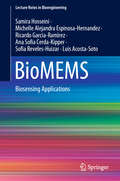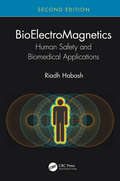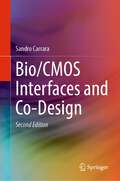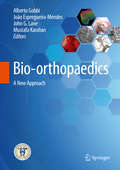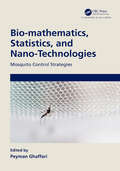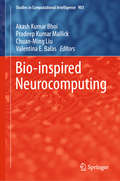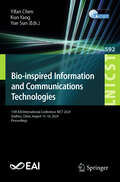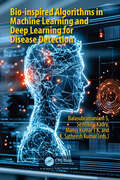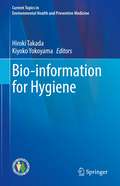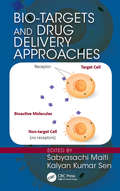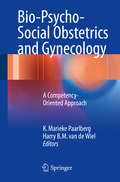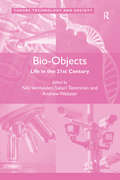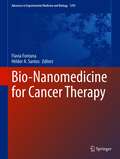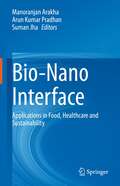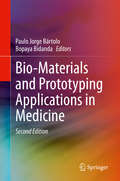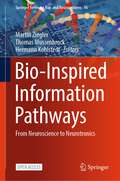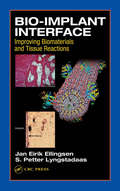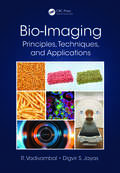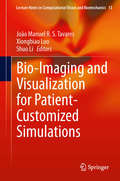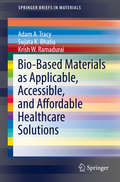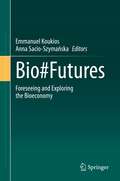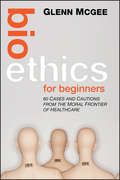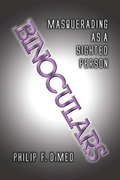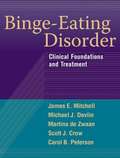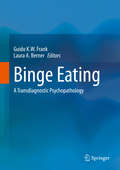- Table View
- List View
BioMEMS: Biosensing Applications (Lecture Notes in Bioengineering)
by Samira Hosseini Michelle Alejandra Espinosa-Hernandez Ricardo Garcia-Ramirez Ana Sofia Cerda-Kipper Sofia Reveles-Huizar Luis Acosta-SotoThis book highlights the latest advances in bioMEMS for biosensing applications. It comprehensively reviews different detection methods, including colorimetric, fluorescence, luminescence, bioluminescence, chemiluminescence, biochemiluminescence, and electrochemiluminescence, and presents various bioMEMS for each, together with recent examples. The book also offers an overview of the history of BioMEMS and the design and manufacture of the first bioMEMS-based devices.
BioElectroMagnetics: Human Safety and Biomedical Applications
by Riadh HabashThis book is an educational resource of evolving scientific knowledge in the area of bioelectromagnetics that may serve the interests of students and decision-makers, as well as society as a whole. It is distinguished by extensive descriptions of fundamental biophysical concepts and their relevance to human health. Reflecting the transdisciplinary approach from several different intellectual streams including physics, biology, epidemiology, medicine, environment, risk science, and engineering, the book is quite a venture into the battling studies to assess the latest research on health effects and biomedical applications of EM energy. This new edition of the book particularly looks at the potential threats from the emerging 5G wireless networks, which will deploy large numbers of low-powered smartphones, notebooks, tablets, radio access networks, and other transmitters. Features Introduces necessary biophysical principles of EM fields in the context of their interaction with living systems. Strengthens understanding of cutting-edge research on several major areas in the broad area of bioelectromagnetics. Presents safety standards and guidelines for human exposure to EM fields. Discusses techniques that have been developed to ensure adequate EM-thermal dosimetry required for both health effects and biomedical applications. Provides insight into the determinants of EM health risk assessment and public concerns. Includes extensive reference list at the end of each chapter to enhance further study. Riadh Habash is a special appointment professor and McLaughlin Research Chair in Electromagnetic Fields and Health at the University of Ottawa, Canada. He has been the recipient of many awards, including the National Wighton Fellowship Award, and has authored or co-authored over 90 research articles, six books, and five book chapters. His most recent books are Green Engineering in 2017 and Professional Practice in 2019 (CRC Press), with the remaining previous books targeting the area of bioelectromagnetics.
Bio/CMOS Interfaces and Co-Design
by Sandro CarraraThis textbook demonstrates new paradigms for the interface between CMOS circuits and the biological world. A deep theoretical description of such an interface is defined and discussed, while various real applications are demonstrated by also discussing several analog CMOS circuits. Electrochemical techniques are proposed in detail to learn how to design integrated biosensors. Biological materials are described to provide devices selectivity. Nanoscale materials are discussed to provide device sensitivity. CMOS circuits are analyzed to provide real applications. Extensive examples with solutions are provided, as well as exercises at the end of each chapter. This book introduces students to the state-of-the-art in Bio/CMOS interfaces, describing leading-edge research in CMOS design and VLSI development for applications requiring intimate integration of biological molecules onto the chip. It provides multidisciplinary content ranging from biochemistry to CMOS design in order to address Bio/CMOS interface co-design in biosensing applications.
Bio-orthopaedics: A New Approach
by Mustafa Karahan Alberto Gobbi João Espregueira-Mendes John G. LaneThis book introduces the exciting field of orthobiology, which will usher in a new array of therapeutic approaches that stimulate the body's natural resources to regenerate musculoskeletal tissues damaged by trauma or disease. The book addresses a range of key topics and discusses emerging approaches that promise to offer effective alternatives to traditional treatments for injuries to bone, cartilage, muscles, ligaments, and tendons. It explains in detail how a variety of innovative products, including biomaterials, growth factors, and autogenous cells, together provide the basis for the regeneration of these musculoskeletal structures and how recent scientific progress has created unique opportunities to address pathological situations that until recently have been treated with unsatisfactory results. The authors are experts from across the world who come together to provide a truly global overview. The book is published in collaboration with ISAKOS. It will be invaluable for all with an interest in this area of medicine, which has already attained huge popularity in Orthopaedics and Sports Medicine and has also attracted the attention of the lay public.
Bio-mathematics, Statistics, and Nano-Technologies: Mosquito Control Strategies
by Peyman GhaffariFinding effective methods for mosquito control remains one of the great global challenges facing this generation. Bio-mathematics, Statistics and Nano-Technologies: Mosquito Control Strategies brings together experts from a large array of disciplines in order to provide a comprehensive overview of cutting-edge techniques to model, analyse and combat mosquito-transmitted vector-borne diseases. Features Includes multiple case studies Suitable for scientists and professionals working on methods for mosquito control and Epidemiology Provide a much-needed focal point for interdisciplinary discussion
Bio-inspired Neurocomputing (Studies in Computational Intelligence #903)
by Akash Kumar Bhoi Valentina E. Balas Pradeep Kumar Mallick Chuan-Ming LiuThis book covers the latest technological advances in neuro-computational intelligence in biological processes where the primary focus is on biologically inspired neuro-computational techniques. The theoretical and practical aspects of biomedical neural computing, brain-inspired computing, bio-computational models, artificial intelligence (AI) and machine learning (ML) approaches in biomedical data analytics are covered along with their qualitative and quantitative features. The contents cover numerous computational applications, methodologies and emerging challenges in the field of bio-soft computing and bio-signal processing. The authors have taken meticulous care in describing the fundamental concepts, identifying the research gap and highlighting the problems with the strategical computational approaches to address the ongoing challenges in bio-inspired models and algorithms. Given the range of topics covered, this book can be a valuable resource for students, researchers as well as practitioners interested in the rapidly evolving field of neurocomputing and biomedical data analytics.
Bio-inspired Information and Communications Technologies: 15th EAI International Conference, BICT 2024, Quzhou, China, August 15–16, 2024, Proceedings (Lecture Notes of the Institute for Computer Sciences, Social Informatics and Telecommunications Engineering #592)
by Kun Yang Yue Sun Yifan ChenThis book constitutes the refereed proceedings of the 15th EAI International Conference on Bio-inspired Information and Communications Technologies, BICT 2024, held in Quzhou, China, during August 15–16, 2024. The 16 full papers included in this book were carefully reviewed and selected from 52 submissions. They were organized in topical sections as follows: Asia-Pacific Workshop on Molecular Communications; Bio-inspired ICT; and ICT-inspired Biomedicine.
Bio-inspired Algorithms in Machine Learning and Deep Learning for Disease Detection
by Seifedine Kadry S Balasubramaniam T K Manoj Kumar K. Satheesh KumarCurrently, computational intelligence approaches are utilised in various science and engineering applications to analyse information, make decisions, and achieve optimisation goals. Over the past few decades, various techniques and algorithms have been created in disciplines such as genetic algorithms, artificial neural networks, evolutionary algorithms, and fuzzy algorithms. In the coming years, intelligent optimisation algorithms are anticipated to become more efficient in addressing various issues in engineering, scientific, medical, space, and artificial satellite fields, particularly in early disease diagnosis. A metaheuristic in computer science is designed to discover optimisation algorithms capable of solving intricate issues. Metaheuristics are optimisation algorithms that mimic biological behaviours of animals or birds and are utilised to discover the best solution for a certain problem. A meta-heuristic is an advanced approach used by heuristics to tackle intricate optimisation problems. A metaheuristic in mathematical programming is a method that seeks a solution to an optimisation problem. Metaheuristics utilise a heuristic function to assist in the search process. Heuristic search can be categorised as blind search or informed search. Meta-heuristic optimisation algorithms are gaining popularity in various applications due to their simplicity, independence from data trends, ability to find optimal solutions, and versatility across different fields. Recently, many nature-inspired computation algorithms have been utilised to diagnose people with different diseases. Nature-inspired methodologies are now widely utilised across several fields for tasks such as data analysis, decision-making, and optimisation. Techniques inspired by nature are categorised as either biology-based or natural phenomena-based. Bioinspired computing encompasses various topics in computer science, mathematics, and biology in recent years. Bio-inspired computer optimisation algorithms are a developing method that utilises concepts and inspiration from biological development to create new and resilient competitive strategies. Bio-inspired optimisation algorithms have gained recognition in machine learning and deep learning for solving complicated issues in science and engineering. Utilising BIAs learning methods with machine learning and deep learning shows great promise for accurately classifying medical conditions. This book explores the historical development of bio-inspired algorithms and their application in machine learning and deep learning models for disease diagnosis, including COVID-19, heart diseases, cancer, diabetes and some other diseases. It discusses the advantages of using bio-inspired algorithms in disease diagnosis and concludes with research directions and future prospects in this field.
Bio-information for Hygiene (Current Topics in Environmental Health and Preventive Medicine)
by Hiroki Takada Kiyoko YokoyamaThis book outlines the electro-activity in the human body, human behavior, and other bio-information during image viewing and applies it to a hygienic and clinical setting. The book begins by explaining the basic science of brain measurements and the endocrine system, before analyzing the bio-signals obtained from electrocardiogram (ECG), electrogastrography (EGG), electro-oculography (EOG) and much more. As the book subsequently demonstrates, these bio-signals can be measured using wearable devices, and the data can be used to detect undiagnosed diseases and health-relevant abnormalities. Especially in the field of nursing care for the elderly and rehabilitation, these new options for the management and analysis of biological information hold considerable potential. Bio-information for Hygiene offers a valuable resource for both new and established researchers, as well as students who are seeking comprehensive information on environmental/occupational health and health promotion. It will also assist technical staff whose work involves bio-informatics.
Bio-Targets and Drug Delivery Approaches
by Sabyasachi Maiti and Kalyan Kumar SenThe advances in drug delivery systems over recent years have resulted in a large number of novel delivery systems with the potential to revolutionize the treatment and prevention of diseases. Bio-Targets and Drug Delivery Approaches is an easy-to-read book for students, researchers and pharmaceutical scientists providing a comprehensive introduction to the principles of advanced drug delivery and targeting their current applications and potential future developments.
Bio-Psycho-Social Obstetrics and Gynecology: A Competency-Oriented Approach
by K Marieke Paarlberg Harry B.M. van de WielThis book will assist the reader by providing individually tailored, high-quality bio-psycho-social care to patients with a wide range of problems within the fields of obstetrics, gynaecology, fertility, oncology, and sexology. Each chapter addresses a particular theme, issue, or situation in a problem-oriented and case-based manner that emphasizes the differences between routine and bio-psycho-social care. Relevant facts and figures are presented, advice is provided regarding the medical, psychological, and caring process, and contextual aspects are discussed. The book offers practical tips and actions within the bio-psycho-social approach, and highlights important do's and don'ts. To avoid a strict somatic thinking pattern, the importance of communication, multidisciplinary collaboration, and creation of a working alliance with the patient is emphasized. The book follows a consistent format, designed to meet the needs of challenged clinicians.
Bio-Objects: Life in the 21st Century (Theory, Technology and Society)
by Andrew Webster Sakari Tamminen Niki VermeulenIncreasing knowledge of the biological is fundamentally transforming what life itself means and where its boundaries lie. New developments in the biosciences - especially through the molecularisation of life - are (re)shaping healthcare and other aspects of our society. This cutting edge volume studies contemporary bio-objects, or the categories, materialities and processes that are central to the configuring of 'life' today, as they emerge, stabilize and circulate through society. Examining a variety of bio-objects in contexts beyond the laboratory, Bio-Objects: Life in the 21st Century explores new ways of thinking about how novel bio-objects enter contemporary life, analysing the manner in which, among others, the boundaries between human and animal, organic and non-organic, and being 'alive' and the suspension of living, are questioned, destabilised and in some cases re-established. Thematically organised around questions of changing boundaries; the governance and regulation of bio-objects; and changing social, economic and political relations, this book presents rich new case studies from Europe that will be of interest to scholars of science and technology studies, social theory, sociology and law.
Bio-Nanomedicine for Cancer Therapy (Advances in Experimental Medicine and Biology #1295)
by Flavia Fontana Hélder A. SantosThe book covers the latest developments in biologically-inspired and derived nanomedicine for cancer therapy. The purpose of the book is to illustrate the significance of naturally-mimicking systems for enhancing the dose delivered to the tumor, to improve stability, and prolong the circulation time. Moreover, readers are presented with advanced materials such as adjuvants for immunostimulation in cancer vaccines. The book also provides a comprehensive overview of the current status of academic research. This is an ideal book for students, researchers, and professors working in nanotechnology, cancer, targeted drug delivery, controlled drug release, materials science, and biomaterials as well as companies developing cancer immunotherapy.
Bio-Nano Interface: Applications in Food, Healthcare and Sustainability
by Manoranjan Arakha Suman Jha Arun Kumar PradhanThis book discusses the unique interactions of nanoparticles with various biomolecules under different environmental conditions. It describes the consequences of these interactions on other biological aspects like flora and fauna of the niche, cell proliferation, etc. The book provides information about the novel and eco-friendly nanoparticle synthesis methods, such as continuous synthesis of nanoparticles using microbial cells. Additionally, the book discusses nanoparticles' potential impact in different areas of biological sciences like food, medicine, agriculture, and the environment. Due to their advanced physicochemical properties, nanoparticles have revolutionized biomedical and pharmaceutical sciences. Inside the biological milieu, nanoparticles interact with different moieties to adopt stable shape, size, and surface functionalities and form nano-biomolecular complexes. The interaction pattern at the interface form complexes determines the fate of interacting biomolecules and nanoparticles inside the biological system. Understanding the interaction pattern at the nano-bio interface is crucial for the safe use of nanoparticles in natural sciences. This book rightly addresses all questions about the interaction and the ensuing structure and function of these nano-biomolecular complexes. This book caters to students and researchers in the area of biotechnology, microbiology, and pharmaceutical sciences.
Bio-Materials and Prototyping Applications in Medicine
by Paulo Jorge Bártolo Bopaya BidandaRapid prototyping is used to design and develop medical devices and instrumentation. This book details research in rapid prototyping of bio-materials for medical applications. It provides a wide variety of examples of medical applications using rapid prototyping, including tissue engineering, dental applications, and bone replacement. Coverage also discusses the emergence of computer aided design in the development of prosthetic devices.
Bio-Inspired Information Pathways: From Neuroscience to Neurotronics (Springer Series on Bio- and Neurosystems #16)
by Martin Ziegler Thomas Mussenbrock Hermann KohlstedtThis open access book offers a timely and comprehensive review of the field of neurotronics. Gathering cutting-edge contributions from neuroscientists, biologists, psychologists, as well as physicists, microelectronics engineers and information scientists, it gives extensive information on fundamental information pathways in selected nervous systems. It also highlights their relevance as building blocks for novel computing architectures, such as bio-inspired electronic devices, neuromorphic architectures, memristive devices, adaptive sensors and emergent, pulsed-coupled oscillatory networks. All in all, this book offers a unique bridge between fundamental research in neuroscience, neural information processing, nonlinear dynamics, and self-organization, and advanced practical applications concerning the fabrication of hardware-oriented computing.
Bio-Implant Interface: Improving Biomaterials and Tissue Reactions
by J.E. Ellingsen S.P. LyngstadaasAchieving good clinical outcomes with implanted biomaterials depends upon achieving optimal function, both mechanical and biological, which in turn depends upon integrating advances realized in biological science, material science, and tissue engineering. As these advances push back the frontiers of biomaterial medicine , the control and patterning
Bio-Imaging: Principles, Techniques, and Applications
by Rajagopal Vadivambal Digvir S. JayasHighlights the Emergence of Image Processing in Food and AgricultureIn addition to uses specifically related to health and other industries, biological imaging is now being used for a variety of applications in food and agriculture. Bio-Imaging: Principles, Techniques, and Applications fully details and outlines the processes of bio-imaging applica
Bio-Imaging and Visualization for Patient-Customized Simulations (Lecture Notes in Computational Vision and Biomechanics #13)
by Xiongbiao Luo Shuo Li João Manuel R. S. TavaresThis book contains the full papers presented at the MICCAI 2013 workshop Bio-Imaging and Visualization for Patient-Customized Simulations (MWBIVPCS 2013). MWBIVPCS 2013 brought together researchers representing several fields, such as Biomechanics, Engineering, Medicine, Mathematics, Physics and Statistic. The contributions included in this book present and discuss new trends in those fields, using several methods and techniques, including the finite element method, similarity metrics, optimization processes, graphs, hidden Markov models, sensor calibration, fuzzy logic, data mining, cellular automation, active shape models, template matching and level sets. These serve as tools to address more efficiently different and timely applications involving signal and image acquisition, image processing and analysis, image segmentation, image registration and fusion, computer simulation, image based modelling, simulation and surgical planning, image guided robot assisted surgical and image based diagnosis. This book will appeal to researchers, PhD students and graduate students with multidisciplinary interests related to the areas of medical imaging, image processing and analysis, computer vision, image segmentation, image registration and fusion, scientific data visualization and image based modeling and simulation.
Bio-Based Materials as Applicable, Accessible, and Affordable Healthcare Solutions (SpringerBriefs in Materials)
by Sujata K. Bhatia Krish W. Ramadurai Adam A. TracyIn this book, Nigeria, the most populous country in Africa and a region in the lowest income group per capita, is used to demonstrate the potential for healthcare reorganization and collaboration with the introduction of "successful" technologies centered around available, bio-compatible, and sustainable natural resources. Our book discusses three of the top killers of children under 5 years of age in Nigeria, pneumonia (20%), diarrheal diseases (15%), and traumatic injuries (4%). These conditions are used as examples to demonstrate the potential for improved pediatric outcomes with treatments engineered from sustainable and natural resources. Furthermore, this book outlines possible action items that can help drive economic growth, educational opportunities, collaborative outreach, and workforce productivity to build a healthy and sustainable community. Medical technology in the industrialized world has seen rapid advancements leading to increased survival and greater patient outcomes. However, the development and implementation of these resources is not always applicable to regions in need of new and more basic ways to provide treatment. Moore's Law, a paradigm that considers advancement synonymous with increased digitization and optimization of electronic processes, defines the history of technology. However, the functionality of advanced and "smart" technology is essentially useless in underdeveloped areas. These regions lack some of the basic requirements for innovative medical technologies to impact human health, such as electricity, access to spare parts, computer analysis tools, and network architecture. In addition, the poor physical infrastructure, insufficient management, and lack of technical culture are barriers for entry and sustainability of these technologies. Rather than importing medical devices from industrialized countries, we propose that the mindset and research focus for under developed areas must be on "successful" technologies. Simply put, these areas need technology that "gets the job done. "
Bio#Futures: Foreseeing and Exploring the Bioeconomy
by Emmanuel Koukios Anna Sacio-SzymańskaThis volume presents a timely recognition, warning and mapping of the fast approaching wave, or “bio-tsunami”, of global socio-technical transformation, built by a much wider spectrum of converging powers, including biotechnology, new agriculture, novel foods, health, quality of life, environment, energy, sustainability, education, knowledge management, and design of smart applications. The book contains eight sections corresponding to different clusters of bioeconomic and socio-technical change, as identified by the editors’ “Scanning the Horizon” foresight research; it also offers an integrated view of the future bioeconomy landscape though the convergence of several technologies that affect everyday life. The clusters offer methodologies for forecasting the future bioeconomy, and how these predictions can affect target-setting and the orientation of policies and actions to manage cultural and societal change, and achieve sustainable development in less developed areas. The book will be of interest to researchers, producers, logistics experts, policy makers, regulators, business and financial institutions, and biotechnologists (e.g. geneticists, food experts, etc.).
Bio Ethics for Beginners
by Glenn McgeeHow far is too far? 60 cases illustrating modern bioethical dilemmas Bioethics for Beginners maps the giant dilemmas posed by new technologies and medical choices, using 60 cases taken from our headlines, and from the worlds of medicine and science. This eminently readable book takes it one case at a time, shedding light on the social, economic and legal side of 21st century medicine while giving the reader an informed basis on which to answer personal, practical questions. Unlocking the debate behind the headlines, this book combines clear thinking with the very latest in science and medicine, enabling readers to decide for themselves exactly what the scientific future should hold.
Binoculars
by Philip F. DimeoFor over 14 years, Philip DiMeo, a talented cartoonist and social worker, led a double life, masquerading as a fully sighted person, while becoming blind. What prompted him to hide his condition? Pride, and fear that if his impending blindness were discovered he would lose all that was important. He concealed his vision loss, a secret that he believed could potentially ruin his life, but in hindsight opened doors. At most social functions, fearful that he would trip, bump into someone, or knock something over, his wife propelled him around. Ignoring warnings from his ophthalmologist, he continued driving despite a series of auto accidents which included driving onto railroad tracks while an oncoming train approached. Philip reveals that, despite diagnoses by three ophthalmologists and three optometrists, he denied having retinitis pigmentosa, an inherited degenerative eye disease that causes severe vision impairment and often blindness. When Philip finally confronted his disability, he found that the challenges of his vision loss were the springboard to achievements to come. Binoculars is a sensitive, amazing, and astonishingly revealing first-hand account of a man who achieves incredible feats with his courage and talent, while finally coming to terms with his blindness
Binge-Eating Disorder
by James Mitchell Michael DevlinThis innovative scientific reference and clinical tool is virtually two books in one. Part I thoroughly yet succinctly reviews the literature on binge-eating disorder, covering diagnosis and epidemiology, clinical features and course, links to obesity, medical risks, and current treatment data. Part II provides an evidence-based cognitive-behavioral treatment manual. Session-by-session guidelines address how to help individuals or groups change their eating behavior, cope with emotional triggers, restructure problematic thoughts, deal with body image concerns and associated problems, maintain improvement, and prevent relapse. Featured are more than 40 clearly explained homework assignments and handouts, all in a large-size format with permission to photocopy.
Binge Eating: A Transdiagnostic Psychopathology
by Guido K. W. Frank Laura A. BernerThis book provides a comprehensive overview of our current understanding of binge eating, which is characterized by the uncontrollable consumption of large amounts of food in a discrete time period. Written by experts on eating disorders, it first introduces the phenotype of binge eating, including its epidemiology and assessment. It then describes the underlying neurobiological alterations, drawing on cutting-edge animal models and human studies to do so. In addition, it extensively discusses current treatment models, including medication, psychotherapy, self-interventions and disease prevention. Lastly, an outlook on the future research agenda rounds out the coverage. Given binge eating’s current status as an under-researched symptom, but one shared across many eating disorders, this book provides an up-to-date, integrative and comprehensive synthesis of recent research and offers a valuable reference for scientists and clinicians alike.
